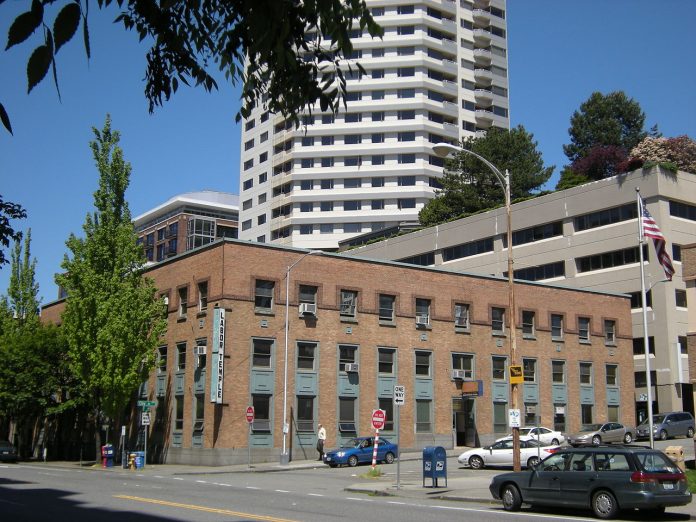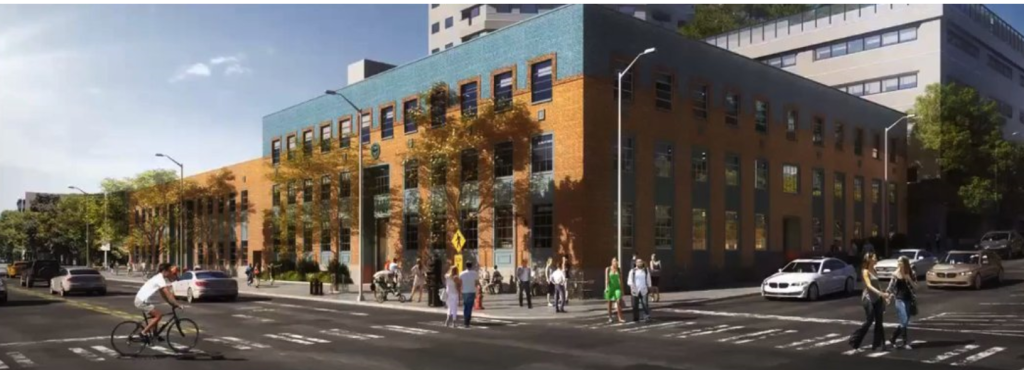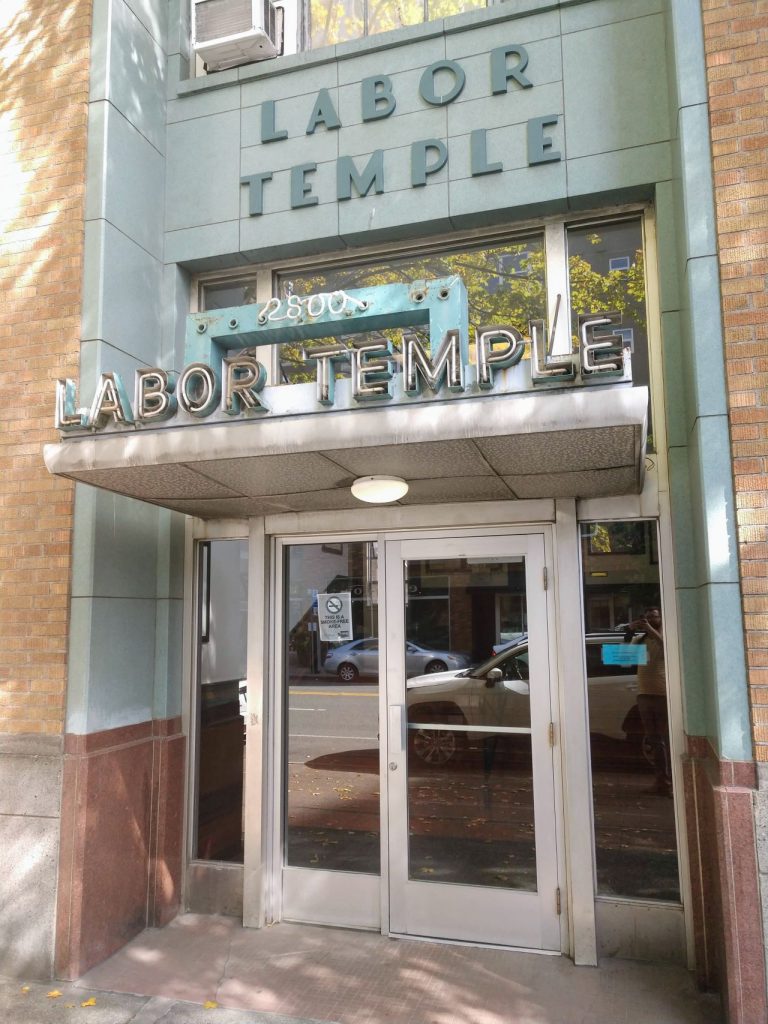
Among the victims of 2020 is the Seattle Labor Temple, which the association of unions that manages the building put up for sale last summer. The 1942 Art Deco building on the corner of 1st Avenue and Clay Street in Belltown will be renovated and converted to a co-working space and social club for business executives. VIA Architecture mocked up designs for a 16-story apartment tower to rise above the preserved podium back in 2018, but that plan isn’t certain yet. The developer, FAUL, meanwhile is working on a plan to preserve and renovate the existing structure.
It would be easy to paint the developer as a villain here, but the Labor Temple Association is optimistic about the deal. Heartland has even agreed to help locate a new site for the unions that call the temple home.
The Third Labor Temple
“The plan is to relocate and create the third Labor Temple… the next awesome Labor Temple, someplace close to the light rail,” UNITE HERE Local 8 President Erik Van Rossum said in a 2018 interview with the Daily Journal of Commerce. “We’re excited. It’s a great opportunity.”
Earlier this month, Van Rossum confirmed the Labor Temple Association had zeroed in on a site in South Seattle for the new labor temple, but wouldn’t disclose the exact site until the deal closes. Selling its valuable Belltown real estate will give the association a boost, but not enough to fully cover the move.

“It is a little difficult for the labor temple right now because the building we are selling and the building we are buying is going to leave us with a multi-million dollar hole,” Van Rossum said. “But in the long run it’s going to the right decision, and we’re going to look at that beautiful building for many years to come. So, all worth it.”
Van Rossum came across as a full-bore historic preservationist, supporting other recent campaigns like Save the Showbox and the fight to block a 14-story boutique hotel opposite Pike Place Market and recounting earlier battles with hotel developer Richard Hedreen, a frequent foe for UNITE HERE Local 8, which represents hotel workers.
Earlier this month, I had offered an alternate take on the labor temple. Building preservation where the use isn’t preserved felt a little empty to me. Under union management, the Seattle Labor Temple has been one of the premier affordable meeting spaces in the core of Seattle. I’ve gathered there many times for events or meetings with the Move All Seattle Sustainably (MASS) coalition or the Transit Riders Union. Public meetings are unlikely to continue there once it’s a swanky members-only social club and coworking space.
Joe Mizrahi, secretary-treasurer with United Food and Commercial Workers (UFCW) 21, the largest private-sector union in the state, offered that preservation costs likely hurt the resale cost too. That said, preserving the use in addition to the building exterior would be difficult without a dedicated funding stream and the museum route is complicated by fact that the Museum of History and Industry (MOHIA) already exists in a similar vein, Mizrahi noted.
“I’m not a tenant so I wouldn’t presume to speak for them but my guess is that it was mostly a pain in the butt that impacted the sale price negatively,” Mizrahi tweeted. “History is great but I’m sure most unions would rather have the [money] to spend on organizing workers.”
The first Seattle Labor Temple, built in 1905, stood at the site of One Union Center, a 36-story office tower at Sixth and University, before the labor council moved into the Belltown site. The Labor Temple Association is looking south to site the new temple farther south since their working class membership increasingly lives in South King County, Van Rossum said. Among the temple tenants is MLK County Labor Council, which represents more than 150 unions and 100,000 workers.
The designs for the Labor Temple redevelopment must make it through the Seattle Landmarks Preservation Board since the building was designated a landmark in 2010. That approval hit a snag as the Landmarks board objected to the brick choice and lobby alterations, friend of the publication Mark Ostrow reported. The south side of the building, which is three stories will be shared working space, Van Rossum said. The north meeting hall side of the temple was sold and is being developed separately from the rehabilitated co-working space. Van Rossum said the plan for a 16-story may have fallen through.
“My understanding is that there would not be a tower on the north of the building, which I think they could do,” Van Rossum said. “We were hoping it would remain intact and that’s what I hear is going to happen.”
The Labor Temple Association put the building up for landmarks consideration as it was contemplating the future of the building and weighing options. The aging building needs repairs and earthquake retrofits. Unions have bought shares in the Seattle Labor Temple Association and their shares correspond to voting rights, Van Rossum explained. The boilermakers union have the most shares, and UNITE HERE Local 8, MLK Labor, and UFCW 21 also hold significant shares, among others. Some have offices in the temple, and some don’t — including the boilermakers.
Rather than take on the costly renovations themselves, the unions have leveraged the value of the Belltown site to find a new site less mildewed and prone to collapse in an earthquake with better access for both transit users and motorists.
“Seattle is such a difficult bottleneck for workers to get to,” Van Rossum told the Daily Journal of Commerce in 2018. “With the viaduct coming down, getting to the Labor Temple will be even more difficult.”
Light rail is a 20-minute walk from the labor temple, and that will improve only marginally when Uptown Station opens along with Ballard Link. (This of course is a reminder that Belltown could really use a high capacity transit stop.)
Changing dynamics for MLK Labor
Unions continue to be a political force in the region, though labor is embattled nationally with high-powered conservative groups setting sights on organizing rights for decades. Locally, the past decade had started as one of a cozying relationship between big labor and big business. When Ed Murray ran for Mayor in 2013, he did so with the backing of MLK Labor, the Seattle Metropolitan Chamber of Commerce, and the Seattle Police Officers Guild (SPOG). SPOG invested heavily on behalf of Murray, which opponent Mike McGinn attributed to Murray pledging to oust pro-reform Police Chief Jim Pugel.
Disagreements over taxes and housing investments eventually frayed that relationship with unions mostly backing the ill-fated 2018 head tax and overwhelmingly backing a larger successful JumpStart Seattle plan, the Chamber opposes both. So despite uniting to back Murray and Jenny Durkan, MLK Labor and the Chamber mostly found themselves on opposite sides in the 2019 election, and the Chamber didn’t do too well without labor help or a progressive facade to hide behind.

Differing views of police threatened to fracture the labor council last summer. By a fairly close vote, MLK Labor voted to expel SPOG from its ranks following Seattle Police Department’s violent crackdown on protesters demanding accountability for George Floyd, Breonna Taylor, and other Black people killed by police.
SPOG had been a relatively recent addition to MLK Labor, but its membership had helped pressure the Seattle City Council into accepting a labor contract that stripped out accountability measures put into place by the Obama Administration initiated Consent Decree process aimed at curbing police killings and brutality. Only Councilmember Kshama Sawant voted against the police contract in 2018.
With a new labor temple planned in South Seattle, organized labor seems to be planting a flag in the sand that they’re on the side of the communities of color and ready to fight. It’s a welcome signal.
Future of historic preservation?
As for Seattle’s historic preservation system, it does seem there’s plenty of room for improvement. A building can see a seemingly unlimited number of historic designation attempts, whether by the owner, a historic society, or a concerned citizen. The threat of red tape can tilt the scales away from redevelopment, which is great if we’re saving Pioneer Square from being turned into parking lots — a massive benefit won by earlier preservationists. The red tape and disincentive for exciting new architecture is less exciting if a publicly accessible building is privatized and all the public gets is a historic facade — and less housing.
Correction: The latest renderings were incorrectly attributed to VIA Architecture. In fact, the architect is Kenneth Wilson and the developer is FAUL for the Labor Temple preservation.
Doug Trumm is publisher of The Urbanist. An Urbanist writer since 2015, he dreams of pedestrian streets, bus lanes, and a mass-timber building spree to end our housing crisis. He graduated from the Evans School of Public Policy and Governance at the University of Washington in 2019. He lives in Seattle's Fremont neighborhood and loves to explore the city by foot and by bike.

